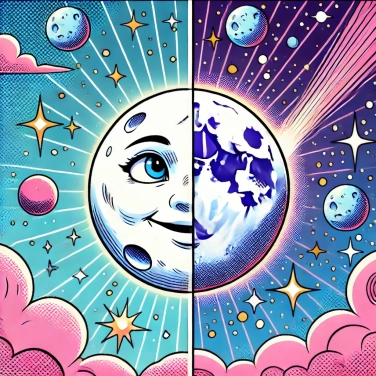The Moon always shows the same face to the Earth due to synchronous rotation: it takes exactly the same amount of time to rotate on its axis as it does to orbit the Earth. This synchronization is due to tidal forces that have gradually slowed its rotation.

The Moon rotates on its axis at exactly the same rate that it orbits the Earth. This is called synchronous rotation. Basically, it takes about 27.3 days to complete one rotation on its axis and exactly the same time to complete one revolution around the Earth. As a result, it always shows the same face towards us, while the other side, known as the "far side", remains completely hidden from view from the Earth. This synchronization is not a coincidence at all; it is a direct result of the effect of Earth's gravity on the Moon, but we will discuss that in detail shortly.
Tidal forces are simply due to gravity. The Earth exerts a significant attraction on the Moon, to the point of creating a slight deformation. This deformation causes a slight "bulge" on the Moon, which initially tried to rotate differently. Over time, this phenomenon acts as a gradual brake on the Moon's rotation. Little by little, this rotation slowed down until it exactly matched the duration of its orbit around the Earth: as a result, we always see the same face. Today, the Moon consistently presents the same side toward our planet, a phenomenon called synchronous rotation. Moreover, the Moon also exerts a similar effect on the Earth, which explains ocean tides.
This synchronous rotation makes direct observation of the far side of the Moon from Earth impossible. As a result, we have always only seen one familiar side, known as the near side. Out of curiosity, this has long left many mysteries about what was hidden on the other side, leading to all sorts of fantasies and far-fetched theories. Another nice consequence: this synchronization also means that when we look at the Moon, we always come across the same craters, mountains, and lunar "seas." As a result, we have learned to know certain lunar areas like the back of our hand, while the other side remained completely unknown until modern times, accessible only from space thanks to space missions.
For a long time, the far side of the Moon remained completely unknown, as it was never visible from Earth. This mystery was finally solved in 1959 when the Soviet probe Luna 3 took the first photos of its far side. Since then, various space missions, including Apollo and more recently probes like the Chinese Chang'e 4, have explored and mapped this unknown region. Chang'e 4 even became the first to land on the far side in 2019. Thanks to these missions, it has been discovered that this hidden side has a more rugged landscape, with more craters and fewer large flat areas (called seas) compared to the side visible from our perspective. Today, exploration continues to better understand its geology, formation, and to prepare for future bases or observation stations.
The far side of the Moon was first observed in 1959 by the Soviet probe Luna 3. Before that, no one on Earth had ever seen it.
Although it is called the dark side of the Moon, it is not always shrouded in darkness. It also experiences day-night phases similar to the visible side.
The far side of the Moon has more craters than the visible side because it offers less protection against meteorite impacts from deep space.
Communication with devices located on the far side of the Moon requires relay through a satellite, as radio signals cannot directly traverse the lunar mass.
No, the far side of the Moon is never visible from Earth due to its synchronous rotation. Only indirect observation via space probes allows us to view this region.
Yes, several space missions, notably the Chinese mission Chang'e 4, have explored and studied the far side of the Moon. This mission successfully achieved a historic landing in this part of the Moon in 2019.
Yes, the dark side receives as much sunlight as the light side. The term 'dark' refers only to its visibility from Earth, and not to its exposure to the Sun.
No, 'dark side' is an expression often misused to refer to the hidden side. In reality, each side of the Moon alternates between day and night. It would be more accurate to speak of the 'invisible' side from our planet.
No, synchronous rotation is very common in the Universe. Many natural satellites, such as those of Jupiter or Saturn, also exhibit synchronous rotation with their planet.

No one has answered this quiz yet, be the first!' :-)
Question 1/8